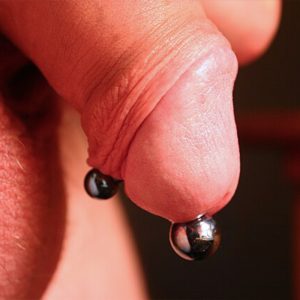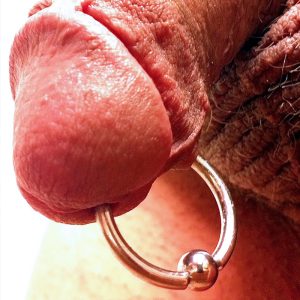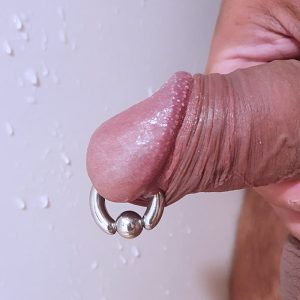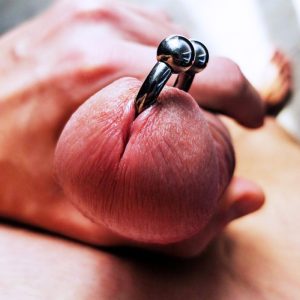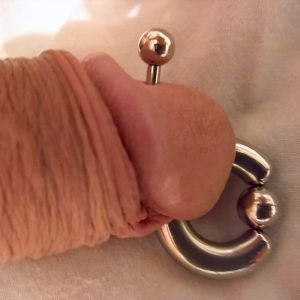Have you ever ventured into the captivating realm of intimate piercings, beyond the common nipples, clits, and vulvas? If so, the Prince Albert piercing, a unique form of penis piercing, might catch your attention. But for many, the idea of a penis piercing, like the Prince Albert, can seem intimidating and shrouded in mystery.
What exactly is a Prince Albert piercing? How can it influence your sexual experiences? Does it live up to the intriguing hype that surrounds it?
Let’s embark on a journey to demystify the enigmatic Prince Albert piercing. We will explore its history, significance, and potential benefits, aiming to provide you with a comprehensive understanding that can help you make an informed decision about this unique male genital piercing.
Key Points
- The Prince Albert (PA) piercing is the most popular male genital piercing.
- It involves inserting jewelry through the urethra and out the base of the head.
- The placement of the piercing depends on the anatomy, often avoiding the frenum cord.
- Circumcision is recommended for better comfort and healing, although it can be done on uncircumcised individuals.
- Adapting to the Prince Albert piercing required some small lifestyle changes, such as altered urination habits.
- Jewelry options for the PA piercing include curved barbells, circular barbells, captive bead rings, or Prince Albert wands.
What is a Prince Albert Piercing?
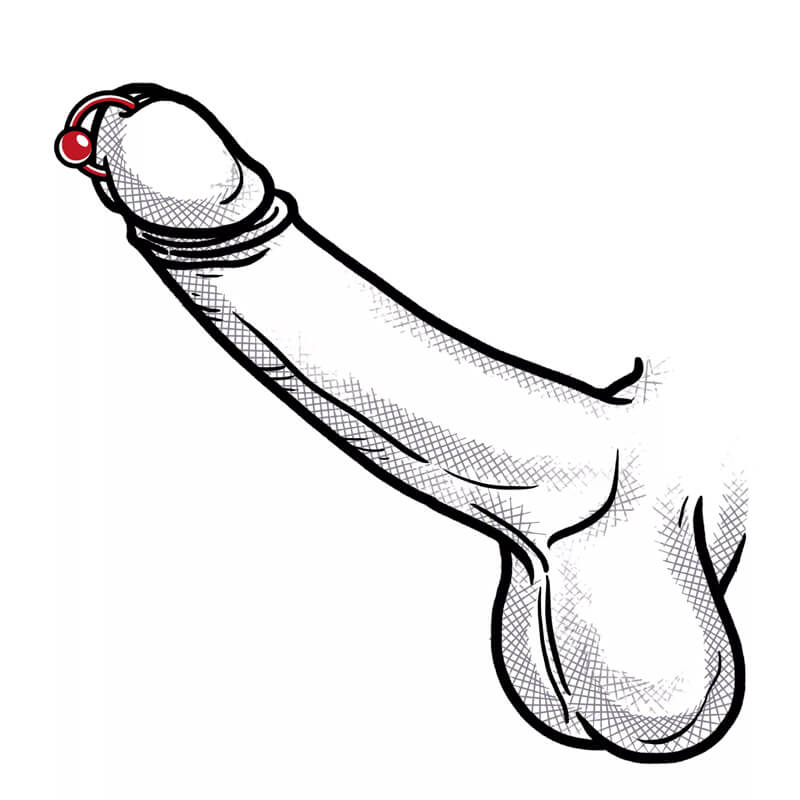
A Prince Albert piercing (PA), also known as a PA piercing, holds a distinguished position in the realm of male genital piercings due to its uniqueness and aesthetic allure. This penis piercing method involves threading jewelry through the urethra, exiting at the base of the penis’s glans. The PA piercing is an anatomy-dependent procedure, meaning that the individual’s physical structure plays a critical role in its placement.
One crucial anatomical aspect to consider is the frenum cord that extends down the center. In most cases, it’s recommended to circumvent this cord during the piercing procedure if it’s sufficiently thick, usually favoring one side over the other for the piercing’s placement.
The PA piercing has a particular appeal because of its distinctive positioning and the aesthetic charm it offers. However, it’s important to note that circumcision status can influence the decision to get a prince albert piercing. It’s typically suggested for individuals considering this type of piercing to be circumcised, as being uncircumcised may result in discomfort and potentially impede the healing process. However, this is not a strict requirement; there have been cases of successful Prince Albert piercings on uncircumcised people.
| Type of Piercing | Placement | Pricing | Pain Level | Healing Time |
|---|---|---|---|---|
| Prince Albert Piercing | Through the frenulum and out the urethra of the penis | $50-$100 | 4/10 | 6-8 weeks |
Although the PA piercing stands as a sought-after choice among male genital piercings, successful implementation relies heavily on individual anatomy, circumcision status, and appropriate jewelry selection. Additionally, adhering to proper aftercare practices is essential to ensure smooth healing and ongoing comfort.
Origin of Prince Albert Piercing name
The name “Prince Albert,” associated with this specific type of male genital piercing, intriguingly links back to Queen Victoria’s husband, Prince Albert, a historical figure of significant repute. The association with a figure of such prominence naturally stirs curiosity about the origin of the piercing’s title.
However, it’s important to note that historical documentation that might provide definitive proof of Prince Albert having such a piercing is virtually nonexistent. The connection between the piercing and Prince Albert’s name could well be conjectural or symbolic, rather than being based on factual evidence.
This intriguing association likely surfaced during a period when body piercing witnessed a widespread revival in popular culture, specifically towards the late 20th century. During this period, body art and piercings emerged as a means of personal expression and individuality. The captivating allure of the term “Prince Albert Piercing” may have been a creative marketing strategy, designed to draw attention to this particular type of piercing. This serves as a reminder of how branding can often intertwine with history, creating narratives that, while not factually accurate, capture the public’s imagination and interest.
Prince Albert Piercing Placement
The Prince Albert (PA) piercing is situated at the junction of the penis’s head and shaft, on its underside. The jewelry for this piercing is placed within the urethra and exits through the urethral opening. Men often appreciate the unique sensation of having jewelry in the urethra, although an initial adjustment period may be required. The piercing typically goes through a thin skin layer, as the urethra runs along the penis’s underside and is not centrally located.
If your penis is smaller, or if your urethra is higher, allowing for a significant distance between the piercing and your urethral opening’s lower edge, the piercing can be positioned slightly down the shaft. This modification doesn’t affect the skin thickness but merely situates the piercing further from your penis’s tip. It’s essential to ensure a minimum of 1/2″ of tissue between the flaccid penis’s piercing and the lower edge of your urethra. If you’re considering stretching the piercing to larger gauges, it should encompass at least 5/8″.
A cordlike web is present in the center of the PA piercing area for some men. If this is the case, the piercing can be set slightly off to one side or a little further down the shaft. Piercing through the web should be avoided as it can lead to an unstable, uncomfortable PA, and may even create small flaps of cut tissue. If the skin isn’t webbed, the piercing can be safely positioned right at the center, provided no visible blood vessels are present.
Several factors come into play when deciding the piercing’s placement. Your piercer should avoid visible blood vessels and select the side without them. The jewelry will sit straighter if the piercing aligns with your urethra. Even your preference for dressing to the left or right can influence the placement, as the piercing might be more comfortable on the opposite side.
Men who are uncircumcised can still get a Prince Albert piercing if they can comfortably retract their foreskin enough for the piercing to be appropriately placed. The foreskin should be checked in both positions to confirm that the jewelry will fit correctly. If your foreskin fits tightly over your glans, avoid jewelry that hinders your foreskin from resting in its natural position to prevent a severe complication known as paraphimosis.
Lastly, it’s noteworthy that about 1 in 250 male children are born with a congenital defect called hypospadias, where the urethra’s opening isn’t at the penis’s tip. In severe cases, a PA piercing isn’t advisable. In milder cases, with expert piercer consultation, the piercing might still be feasible by placing it further down the shaft.
Prince Albert Piercing Procedure Explained
The Prince Albert piercing procedure is conducted by a trained professional who meticulously explains each step. The PA piercing procedure starts with you laying down on the designated piercing table, exposing the area to be pierced. The piercing professional begins by examining the anatomy, marking the precise points for piercing, and thoroughly cleaning the area.
@piercingandlife #piercing #piercings #bodypiercing #tattoo #tatuagem #piercinglovers ♬ Dreamers [Music from the FIFA World Cup Qatar 2022 Official Soundtrack] – Jung Kook & BTS
Next comes the step that many deem the most intimidating part of the procedure: the introduction of the receiving tube. This tube, roughly the diameter of a ballpoint pen, is generously lubricated before being carefully inserted about an inch into the urethra. While this might sound daunting, most people find it more uncomfortable than painful. The sensation is often described as an intense urge to urinate rather than actual pain.
Following this, a Captive Bead Ring (CBR) is inserted. It’s crucial at this point to remain utterly motionless to maintain the connection between the ring and the needle. Any disruption could necessitate a re-piercing. Post-piercing, the professional piercer provides aftercare guidance to assist with the initial healing phase.
Despite the initial discomfort, many individuals find the Prince Albert piercing worthwhile due to its potential for stretching. This adaptability allows for the accommodation of larger gauge jewelry, enhancing comfort in the long run. However, accurate placement during the initial piercing is crucial to avoid complications like an off-centered urinary stream.
Interestingly, it’s not uncommon for individuals to experience an erection during the cleaning or marking phase of the procedure. An experienced piercer won’t be surprised by this; in fact, it could help them make a more accurate jewelry measurement, particularly advantageous for specific piercings. However, if an erection persists during the actual piercing phase, it might make the procedure more challenging, if not impossible, for the piercer.
Prince Albert Piercing Pain
Contrary to what one might expect, the Prince Albert piercing procedure isn’t overwhelmingly painful. On a pain scale, it could be roughly estimated at a 4 out of 10. The anxiety leading up to the procedure often overshadows the actual event. The insertion of the receiving tube tends to be the most uncomfortable part, but this discomfort is transitory and fades relatively quickly.
The piercing site is not overly thick, nor is it saturated with nerve endings like the penis’s head. This less sensitive area under the head comprises minimal skin, making the piercing relatively bearable. While it may appear menacing, the actual pain level is often less intense than presumed.
Following the initial piercing, the body naturally releases endorphins in the area, assisting in swiftly reducing the discomfort. Mild pain can persist for a few days, requiring careful management, particularly during urination. A useful tip during the initial days is to urinate into a cup of warm water to alleviate any discomfort.
In terms of pain comparison, every individual’s tolerance varies, and some might find other piercings like nipple piercings to be more painful. The Prince Albert piercing, by comparison, is often described as less painful than it appears.
Remember, pain is highly subjective and varies greatly from person to person. What one person may find a mild discomfort, another may find more painful.
Prince Albert Piercing Healing Process
A common misconception about the Prince Albert piercing is that it’s particularly dangerous or prone to infection due to its location in the urethra. However, contrary to these concerns, it’s usually straightforward to receive and to heal, as long as one maintains proper hygiene and follows the recommended aftercare routine.
-
Piercing Healing Time
The healing time for a Prince Albert piercing typically ranges between 6 to 8 weeks, but individual factors such as general health, hygiene, and adherence to the aftercare routine can affect this timeline. During the initial healing phase, it’s advisable to wear supportive underwear, such as boxer briefs, which provide stability. Loose, comfortable clothing is preferred to minimize any friction against the piercing.
Throughout the healing process, it’s crucial to keep the area clean and free from any buildup on the jewelry. In case of new or sensitive piercings, keeping a glass of ice water by the bedside can help manage painful night or morning erections, especially if there is any dry material on the jewelry.
Hydration plays a vital role in the healing process. Drinking plenty of water helps dilute the urine, thereby reducing any stinging sensation during urination. Additionally, urine is sterile to one’s body, so frequent urination can actually assist in keeping the piercing clean.
As far as sexual activity is concerned, it’s recommended to abstain for at least a month after the procedure, or until the piercing site is no longer tender. Once you can gently tug on the piercing without pain, it’s usually a sign that the area is healed enough for sexual activity.
-
Piercing Aftercare
The aftercare for a Prince Albert piercing involves treating it as a healing wound for at least three months. This includes performing warm water and sea salt soaks twice daily or using saline spray, and cleaning the piercing with antimicrobial or germicidal soap once or twice daily. Avoiding oral contact or exchanging bodily fluids around the piercing is necessary for a minimum of six months. To prevent any potential contamination, it’s also important to keep the area clean, refrain from submerging the piercing in unclean water, and keep pets away from the piercing.
In the first few days after the procedure, it’s common for some scabbing to occur. This can be managed by washing the area twice daily and performing a salt water rinse two to three times a day. Always remember to wash your hands before and after touching the piercing.
PA Piercing Images
Prince Albert Piercing Cost
In order to assess the cost of a piercing in Prince Albert, it is important to consider the overall complexity of the procedure. Genital piercings are generally more expensive than other body piercings due to their specific nature and the specialized training required to perform them. As a result, piercers with such expertise are rarer, which affects the price.
On average, the cost of a Prince Albert piercing ranges from $50 to $100. This cost does not include the tip for the piercer, which is generally considered customary and respectful. Comparatively, female genital piercings, such as the Princess Albertina piercing, often fall within a similar price bracket.
Best Prince Albert Piercing Jewelry
Among the three main options for piercing jewellery in Prince Albert (PA) are curved barbells, circular barbells and captive bead rings.
-
Curved Barbell
A popular choice for Prince Albert piercings is the curved barbell. Its design complements the natural anatomy of the area, offering a comfortable fit due to its ergonomic shape. The curved barbell is a versatile piece of jewelry, adaptable to various piercing locations, but in the context of a Prince Albert piercing, it aligns seamlessly with the curvature of the penis for an unobtrusive fit.
-
Circular Barbell or Ball Closure Ring (BCR)
Known for its circular shape with a closing ball, this type of jewelry is another common choice for Prince Albert piercings. The unique aspect of a BCR is its customizable diameter, allowing for adjustments based on individual comfort and aesthetic preference. Its design lends a distinctive visual appeal to the piercing, making it a favorite amongst many.
-
Captive Bead Ring (CBR)
Sharing similarities with the BCR, a Captive Bead Ring is a circular piece of jewelry featuring a small bead that fits snugly into an opening in the ring. The bead not only adds a decorative touch but also ensures a secure fit. Its design allows the bead to ‘captive’ within the ring, giving this piece of jewelry its name. When used in a Prince Albert piercing, the CBR offers a blend of visual interest and secure, comfortable wear.
-
Prince Albert Wands
The Prince’s Wand, a less common but notable jewelry option for a healed Prince Albert piercing, follows a distinct design. Unlike the curved or circular barbells, the Prince Albert Wands is inserted in a T-shaped manner. The main bar of the jewelry goes directly down the urethra, while a straight bar passes through the frenulum, the sensitive strip of tissue on the underside of the penis, to secure the wand in place. This particular design allows the jewelry to be held firmly without the need for a hanging circle, offering a unique aesthetic and sensation. As always, it’s essential to discuss such options with a professional piercer to ensure suitability and safe insertion.
| Type | Fit | Design | Customization | Usage |
|---|---|---|---|---|
| Curved Barbell | Ergonomic, aligns with natural anatomy for comfort | Curved shape with balls on both ends | Varies in size, material, and ball design | Common choice for Prince Albert piercings |
| Circular Barbell/Ball Closure Ring (BCR) | Comfortable, diameter can be adjusted | Circular shape with a closing ball | Diameter is customizable for personal comfort and aesthetic preference | Widely favored for Prince Albert piercings |
| Captive Bead Ring (CBR) | Comfortable and secure with a bead that fits into an opening | Circular shape with a captive bead | Bead design can be customized | Commonly used for various piercings, including Prince Albert |
| Prince’s Wand | Secure, fits directly into the urethra and fastens underneath | Bar inserted like a T-shape, straight down the urethra | Varies in length and thickness, depending on individual anatomy and preference | Used for more unique and specialized Prince Albert piercings |
Prince Albert Piercing Size & Stretching
The initial jewelry size for a PA piercing should ideally be a minimum of an eight-gauge. However, some piercers may prefer to start with a ten-gauge, subsequently stretching it to an eight-gauge to minimize bleeding – a frequent occurrence with this particular piercing.
An essential aspect to bear in mind is that the jewelry for genital piercings must comfortably accommodate your body during its maximum engorgement. If the jewelry feels too tight during an erection, it’s advisable to return to the piercer at the earliest convenience to obtain a larger piece. Wearing jewelry that’s too small can cause discomfort, migration of the piercing, and complicate the healing process.
Over time, the tissue surrounding the piercing may naturally stretch, necessitating the use of thicker jewelry. Regular adjustments to the jewelry size for optimal comfort and fit are not uncommon. However, some individuals may find this ongoing maintenance aspect of the piercing to be inconvenient.
The process of stretching a Prince Albert piercing involves a gradual increase in the gauge of the jewelry over time. It’s important to remember that this is a personal choice and not a necessity for everyone. If you choose to stretch your piercing, it’s critical to proceed slowly and safely to prevent any potential injury.
Prince Albert Risks & Complications
-
Urination Considerations
One crucial aspect to consider is the potential changes in urination patterns. The presence of the piercing may alter the way urine flows, which can lead to minor inconveniences or messiness. For example, some people may find the piercing causes urine to divert from its usual path, which could cause some awkwardness, particularly when using public urinals. It’s recommended to practice urinating at home first to adjust to these changes. Over time, many individuals learn techniques to manage this, such as manually plugging the piercing hole to avoid split flow or leakage.
-
Increased Risk of Sexually Transmitted Diseases
The piercing could also potentially increase susceptibility to sexually transmitted diseases (STDs). The scar tissue formed around the piercing is often softer and more prone to tearing during sexual activity, which may heighten the risk of STD transmission. Therefore, practicing safe sex, using barriers like condoms, and maintaining good sexual health habits are imperative.
-
Bleeding and Other Complications
Post-piercing bleeding is another concern. It’s common for individuals to experience bleeding for several days following the procedure. To manage this, it’s advisable to wear sanitary pads or napkins to prevent staining of clothing and for overall comfort. Also, consuming acidic drinks post-piercing could cause a burning sensation, so it’s recommended to avoid them for a while. Despite these initial discomforts, rest assured that these are typically temporary and part of the healing process.
Enhancing Sexual Pleasure: The Prince Albert Piercing Effect
The decision to get a Prince Albert piercing is often accompanied by curiosity about its potential impact on sexual activities. Many individuals who have undergone this procedure report experiencing heightened sexual sensations, leading to improved satisfaction for both themselves and their partners.
The effect of the piercing on sexual pleasure can vary. Some individuals may not initially observe a significant enhancement in their sexual experiences. However, adjustments like increasing the ring size can lead to considerable improvements in sexual satisfaction. For instance, switching to a larger 4 or 2 gauge ring has been reported to enhance the sexual experience for some.
Feedback from partners of those with a Prince Albert piercing tends to be positive. Many report enhanced pleasure during intercourse due to the added stimulation provided by the piercing.
However, it’s important to note that the Prince Albert piercing can also increase sexual sensitivity to a substantial degree. This heightened sensitivity can be a double-edged sword. While it can amplify pleasure, it can also lead to the possibility of overstimulation or discomfort. Therefore, using lubrication during sexual activity is often recommended to ensure a smooth and enjoyable experience.
Moreover, listening to your body’s signals is crucial. If sexual activity causes pain or discomfort, it’s advisable to stop and allow time for adjustment or healing. This approach ensures that the enhanced sensitivity brought on by the piercing contributes positively to one’s sexual experiences rather than causing injury or discomfort.
Prince Albert Piercing Pros and Cons
When considering a Prince Albert piercing, it’s essential to weigh the advantages and disadvantages to make an informed decision. Here’s a summary of the pros and cons
Pros:
- Many report enhanced sexual pleasure after getting a Prince Albert piercing, both for themselves and their partners.
- Prince Albert piercing typically heals within 4 to 6 weeks, which is relatively quick compared to other body piercings.
- Aside from initial discomfort, this piercing usually doesn’t interfere with day-to-day activities or overall lifestyle
- The piercing is naturally concealed, making it an ideal choice for individuals who value privacy or those within conservative professional environments.
- There’s a diverse range of jewelry options to choose from, including curved barbells, circular barbells, captive bead rings, and Prince’s Wand. This variety allows for customization and the opportunity to switch up your look.
Cons:
- The piercing can alter the way one urinates, potentially causing inconvenience or messiness. Some individuals may need to adopt new techniques or take extra care during urination.
- The piercing might heighten susceptibility to sexually transmitted diseases due to potential tearing during sexual activity.
- Over time, the tissue around the piercing may naturally stretch, requiring periodic jewelry modifications.
- While boosting sexual pleasure, the piercing might also lead to increased sensitivity, which may be uncomfortable for some.
- Bleeding for several days post-piercing is common, requiring sanitary measures for comfort and cleanliness.
- Depending on personal circumstances and societal norms, genital piercings like the Prince Albert might be subject to negative perceptions.
Prince Albert Piercing: Personal Experiences & Reviews
In the quest for understanding the true essence of a Prince Albert piercing, we delve into the firsthand experiences of those brave enough to undergo this unique and intimate modification. Personal accounts from individuals who’ve traversed this path offer us unique insights into the piercing’s effect on daily life, personal comfort, sexual experiences, and overall satisfaction. These stories of boldness and transformation offer a valuable perspective, bringing to light the reality of living with a Prince Albert piercing.
Experience 1: Upsizing and Sensitivity Enhancement
One piercing enthusiast started his journey with a 2.4mm Prince Albert piercing and subsequently upsized it to 4mm. He found the anticipation of the piercing to be more daunting than the actual procedure, though the placement of the guide tube did cause some discomfort. He found the most challenging part of his healing process was the development of scar tissue, particularly as an uncircumcised individual, noting it to be the most painful aspect of his piercing experience. Both he and another respondent suggested the helpful tip of urinating into a cup of warm water post-piercing to alleviate discomfort.
They both also highlighted the notable increase in sexual sensitivity, emphasizing the importance of being attuned to body signals to avoid injury during sexual activities. The second individual experienced significant bleeding and cautioned against drinking acidic beverages due to the resultant intense burning sensation. Despite these hurdles, both individuals expressed overall contentment with their Prince Albert piercings, confirming that they would willingly undergo the process again.
Experience 2: Curiosity, Adaptation, and Sexual Enhancement
Another individual had harbored a longstanding curiosity about acquiring a Prince Albert piercing. The procedure was carried out professionally, with each step explained clearly, resulting in only moderate discomfort and short-lived bleeding. Comprehensive aftercare instructions were given to manage the initial healing phase. The individual noted lifestyle changes following the piercing, particularly in urination habits, with mild discomfort persisting in the early days. Initially, the piercing didn’t enhance their sexual experiences. However, after upgrading the ring size to a 4 or 2 gauge, they reported a noticeable improvement in sexual gratification.
Although the piercing remained a personal secret, shared only with sexual partners, the responses were overwhelmingly positive, with most partners experiencing enhanced pleasure during intercourse. Despite the initial discomfort and lifestyle adjustments, the individual affirmed that the piercing had added to their sexual experiences and expressed no regrets over their decision, planning to keep their Prince Albert piercing indefinitely.
Experience 3: Anticipation, Procedure, and Aftercare
In a recent account, an individual described their decision to get a Prince Albert piercing after years of consideration and research. The procedure was conducted at a local tattoo and piercing establishment named ‘Ink Dreams’. The piercing involved the insertion of a receiving tube into the urethra, which induced a sensation akin to needing to urinate, but wasn’t extremely uncomfortable. The actual piercing of the frenulum, however, was significantly more uncomfortable, though the discomfort was brief. A Captive Bead Ring was inserted post-procedure, an experience which was well-tolerated.
The piercing was sensitive and tender to the touch post-procedure, particularly with inadvertent bumps or brushes, but not unbearably so. The aftercare regimen included washing and salt-water rinsing, which facilitated healing. Urination was slightly uncomfortable initially but normalized soon thereafter. The piercing altered the flow of urine, which required some adjustment. Sexual activities have been paused since the piercing, with the intention to resume once a comfortable tug on the piercing can be achieved without pain. Despite the initial discomfort, the individual described their overall experience of getting a Prince Albert piercing as positive and fascinating.
Source : Reddit
Prince Albert Piercing Variations
The Prince Albert piercing is not the only option for genital piercings. Some individuals may prefer other types of piercings due to personal preferences, anatomical considerations, or a desire for a different aesthetic. If you’re new to genital piercings, more beginner-friendly options like frenum or scrotum piercings might be recommended. These piercings are generally considered easier to receive and heal than a Prince Albert. The journey into genital piercings is often deeply personal, and many individuals explore and acquire multiple piercings over time.
Here’s a look at some of the main variations of the Prince Albert piercing:
-
Reverse Prince Albert Piercing
While a standard Prince Albert piercing enters the underside of the penis and exits through the urethra, a Reverse Prince Albert piercing (also known as a “Reverse PA” or “RPA”) enters through the urethra and exits through the top of the glans. This variation provides a different aesthetic and sensation compared to the standard PA.
-
Deep Prince Albert Piercing
In a Deep Prince Albert Piercing, the piercing is made further down the shaft. This can be due to personal preference, especially for those who want to wear larger jewelry, or as a result of mild hypospadias. Despite the deeper placement, the tissue is just as pierceable as in a traditional PA, and the healing process is typically similar. The piercing process requires inserting the tube further into the urethra.
-
Dolphin Piercing
The Dolphin Piercing, a variation of the Prince Albert (PA) piercing, involves an extra hole further down the penile shaft. Jewelry is threaded through both piercings for a unique aesthetic. During initial healing, flexible tubing is used for comfort. However, men with significant size differences between flaccid and erect states may find metal jewelry in a Dolphin Piercing uncomfortable. Personal comfort and anatomy should be considered when opting for this piercing.
-
Fake Prince Albert Piercing
For individuals who appreciate the aesthetic of a Prince Albert piercing but aren’t ready for the commitment, fake Prince Albert piercings offer an alternative. These involve a clip or similar mechanism that mimics the appearance of a piercing without requiring an actual puncture.
FAQ
Why is it called a Prince Albert piercing?
The piercing is thought to be named after Queen Victoria’s husband, Prince Albert, although there’s no historical evidence that he actually had the piercing. The name was likely coined during the resurgence of body piercing in the late 20th century.
Can you remove a Prince Albert piercing?
Yes, the jewelry in a Prince Albert piercing can be removed. However, be aware that the piercing can close up quickly once the jewelry is taken out, especially in the first few months after getting the piercing.
Did Prince Albert have a Prince Albert piercing?
There is no historical evidence to suggest that Prince Albert had a genital piercing. The name “Prince Albert piercing” seems to be a product of modern body piercing culture rather than a reflection of historical facts.
What does a Prince Albert piercing look like?
A Prince Albert piercing is a type of male genital piercing that passes through the urethra and exits through the underside of the glans of the penis. The jewelry usually hangs down from the tip of the penis, creating a distinctive look.
Why is it called a Prince Albert piercing?
The origins of the name “Prince Albert piercing” are unclear, but it’s believed to be a marketing gimmick created by contemporary body piercers. There are a number of apocryphal stories about its origins, but none of them are substantiated by historical evidence.

